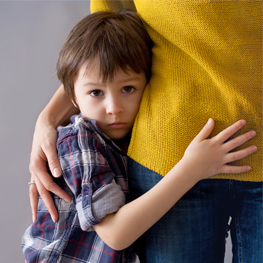
It is normal for your child to feel nervous when it’s time for them to stay with a caregiver. Separation can be difficult for both the child and the parent, but your child can begin to feel comfortable, and separation anxiety will improve with these strategies.
Prepare - Before it’s time to leave your child, discuss what will happen. Let them know you that you will be leaving them with a babysitter, what you will be doing while you are gone, and assure them that you will be back. If possible, plan something fun the child and the caregiver can do together while you are gone. If your child knows what to expect, they have the opportunity to ask questions and ease some of the apprehension they may be feeling.
Practice - Young children, especially infants, benefit from easing into a new routine. For example, try leaving your child for short periods of time before going back to work full-time. By slowly increasing the length of time you are away from your child, they will be able to develop a relationship with the caregiver and adjust to being away from you.
Be consistent - Do your best to use the same caregiver each time you leave so that your child feels more comfortable with them. Your child will spend a lot of time with the babysitter, especially if you and your partner work full-time outside of the home. It is important that your child feels safe and comfortable with the caregiver.
Choose the best time - A child who is sick, hungry, or tired is more likely to struggle with separation anxiety when it is time for you to leave. Make sure your child is fed and rested before it is time for you to leave.
Keep it familiar - If possible, have the caregiver come to your home where your child feels most comfortable. If that is not possible, have the child bring something from home that makes them feel comfortable, such as a special stuffed animal or a blanket, a photo of the family, or a favorite toy. Another idea is to have the caregiver bring a special toy along with them that your child will recognize and associate with the caregiver each time, helping to create consistency and comfort for your child.
Set a time limit - When it is time for you to leave, give your child a time that you will return. Toddlers do not understand the concept of time, but you can let them know they can expect you after a specific activity. Explain that you will be home after lunch; when naptime is done; or when the movie is over (let the caregiver know when to start the movie for your child). This will help your child understand what time you will be home and relax when you leave.
Leave quickly - When it is time for you to go, even if it is as hard for you as it is for your child, leave without fanfare. Say good-bye, give them one last kiss or a hug, remind them that you will be back soon, and leave - quickly! Of all these tips, this is probably the simplest and the most important. Your child is looking to you for how to react to the situation and if you are calm, happy, and confident, they will begin to feel that way, too.
Develop a good-bye ritual - Developing a special good-bye with your child creates consistency, and it is also fun. A good-bye ritual is when you and your child say good-bye the exact same way each day. This routine can help your child feel comfortable when you leave and confident that you will return.
Separation anxiety is age-appropriate for children from infancy to around three years old. These coping strategies can help both you and your child feel at ease when it is time for you to leave them with a caregiver. In time, your child will outgrow their anxiety over separation.
Good-bye rituals
Creating a good-bye ritual with your child can help give them a sense of comfort because they know what to expect. They will feel safe in their surroundings and have confidence that their parent will return, as always.
Here are some ideas to start your own good-bye ritual:
Sarah is a freelance writer, wife, and mother of six.
Calgary’s Child Magazine © 2024 Calgary’s Child